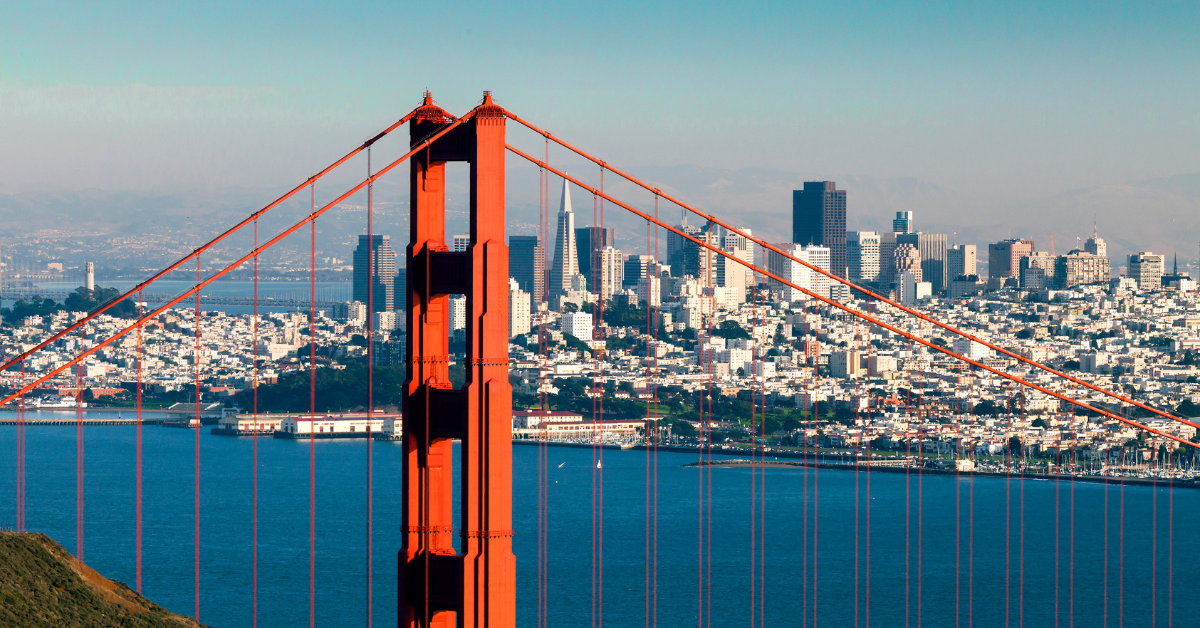San Francisco has long been written in Japan as 桑港 (Sōkō), a kanji expression that reflects both its phonetic sound and its role as a major port city. For Japanese people, this name carries deep cultural associations, from immigration history and resilience after disaster to modern connections through sports and tourism.
The Origin of the Kanji “桑港”
“桑” as a Phonetic Approximation
When transferring “San Francisco” into Japanese, the character 桑 was chosen for its similar sound. While “桑” usually means “mulberry” and is read as kuwa in Japanese, under Chinese-derived readings it can also be pronounced as sō. This made it a suitable choice to approximate the “San” sound.
“港” as a Symbol of the Port City
San Francisco has thrived as a major port city on the West Coast. To highlight this characteristic, the character 港 meaning “harbor” was added, completing the expression 桑港. With just two characters, both the sound and the city’s identity were captured.
| Kanji | Meaning | Relation to San Francisco |
|---|---|---|
| 桑 | Close to the sound “sō” | Used to approximate “San” |
| 港 | Harbor, seaport | Symbolizes San Francisco as a port city |
Japanese Perceptions of “桑港”
Gateway for Immigrants
From the Meiji era onward, many Japanese immigrants first landed in San Francisco. For them, the city represented the “first step into a new world”, full of hope yet also fraught with discrimination and harsh labor. Thus, “桑港” carried a dual image of both opportunity and hardship.
A Symbol of Foreign Culture and Modernity
The city’s hilly streets, cable cars, and European-style buildings left a strong impression. Unlike anything found in Japan at the time, San Francisco was embraced as “a Western city to be admired”, embodying modernity and cosmopolitan charm.
A Symbol of Disaster and Recovery
The 1906 earthquake and fire devastated the city, yet it was rebuilt in a remarkably short time. This resilience gave Japanese observers the impression of “a strong and unyielding city”, reinforcing San Francisco’s image as a symbol of American vitality.
Sports and the Appeal of San Francisco
Connection Through Baseball
San Francisco is home to the Major League powerhouse San Francisco Giants. For Japanese fans, it became a stage of dreams, as Japanese players challenged themselves there. The Giants’ waterfront ballpark, with its view of the bay, is also iconic and deeply tied to the city’s sporting identity.
American Football and Basketball
The San Francisco 49ers (NFL) and the nearby Golden State Warriors (NBA) are globally recognized teams. Their matches are popular among Japanese sports fans, further deepening the cultural connection through sports.
| Sport | Team | Characteristics | Relation to Japan |
|---|---|---|---|
| Baseball | San Francisco Giants | Historic MLB team, waterfront stadium | Japanese players have joined, boosting popularity |
| Football | San Francisco 49ers | Storied NFL franchise | Known in Japan for Super Bowl appearances |
| Basketball | Golden State Warriors | NBA powerhouse in nearby Oakland | Large Japanese fan base |
Tourism and “桑港”
Beyond sports, San Francisco is also cherished by Japanese tourists as a city of iconic landmarks and unique atmosphere. Its combination of historic charm and modern dynamism makes it an enduringly popular destination.
| Landmark | Feature | Appeal to Japanese Visitors |
|---|---|---|
| Golden Gate Bridge | Iconic red suspension bridge | Famous for scenic photos |
| Cable Cars | Historic transit climbing steep hills | Known from movies and postcards |
| Fisherman’s Wharf | Bustling port district | Seafood and waterfront attractions |
The Meaning Behind the Name “桑港”
The two characters in 桑港 symbolize more than just sound. They encapsulate how Japanese people have understood San Francisco:
| Element | Meaning within “桑港” |
|---|---|
| Port | A hub of international exchange |
| Immigration | Entry point to the “new world” |
| Culture | A crossroads of East and West |
| Sports | A stage admired by Japanese fans |
| Tourism | Symbol of foreign charm and world-famous landmarks |
Thus, “桑港” became not only a translation but also a cultural emblem representing San Francisco in the Japanese imagination.
Conclusion
San Francisco came to be written as 桑港 because of its phonetic resemblance and its identity as a port city. For Japanese people, the city represented a gateway to new opportunities, a stage of cultural encounters, and, in modern times, a hub of sports and tourism.
Today, the kanji expression is rarely used, but it still carries a nostalgic resonance. “桑港” is not just an old-fashioned name—it remains a symbolic bridge connecting Japanese memories and San Francisco’s vibrant history.






